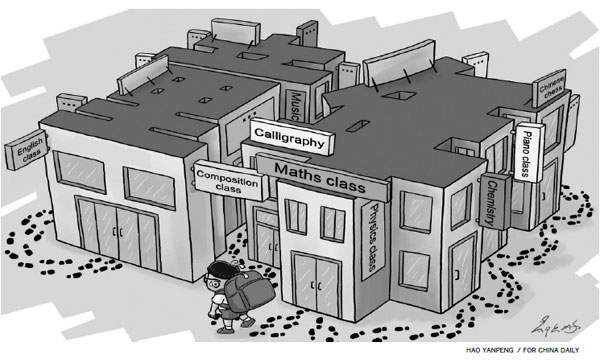Cram schools increase students' burden
Editor's note: The ongoing nationwide campaign to regulate the education sector is aimed at easing the academic burden of elementary and middle school students. While more than 12,000 "cram schools" had been overhauled by the end of May, many people feel the campaign could lead to a broad-brush approach to improve the existing education system. Two experts share their views on the issue with China Daily's Yao Yuxin. Excerpts follow:
Children get little recreation time
Basic education puts emphasis on fulfilling the learning needs of the majority of primary and middle schools students. Thus those with different learning ability have to attend after-school classes to complement their individual learning needs, because a different teacher or learning method could help a student better understand a subject she or he is having trouble with in class.
Given the severe competition to get admitted to good universities, high expectation of parents from their children, there has been a significant increase in the number of "cram schools" in recent years, with many of these schools claiming they can produce instant results and help students pass the exams.
Students need at least 8 hours of sleep. They also need to attend regular classes in school and do homework, which can take hours. So if they also have to attend a cram school every day, they will be left with little or no time to do physical exercise or play with friends, which are necessary for their healthy growth.
Parents should also rethink their belief that studying for long hours can lead to better grades. Instead, they should weigh their children's performance at school and figure out which schedule or rhythm suits their children best before deciding on whether to enroll a child in an after-school course.
Give schools bigger say in enrollment
Just like the exam-oriented education system, the majority of cram schools also aim to raise the scores of students. But when it comes to education that can facilitate students' healthy development, almost all of them are found wanting.
So it is not the overhauling of cram schools but the reform of the college entrance examination system that is key to ending students' over-reliance on after-school classes. Unless the excessive emphasis on exam scores ends, the demand for after-school classes will continue.
Rather than forcing students to conform to the existing academic evaluation system, the authorities should put in place a more scientific and professional examination system to meet the development needs of the students. Besides, as professional educational institutions, schools should be allowed to select students and evaluate their performance based on multiple standards instead of the aggregate score in a particular exam. A student with artistic skills need not be necessarily good at mathematic or physics. So why should such a student have to go through the whole grind to find her or his true calling?
But in spite of the imperfect examination and enrollment system, cram schools are unnecessary. In fact, their number has significantly declined in Japan after the reform of the college entrance examination system.
If multiple standards were used for college admission, schools could find new ways, without focusing exclusively on scores, to help develop students' interests in learning, which in turn would promote the healthy development of the students.



















